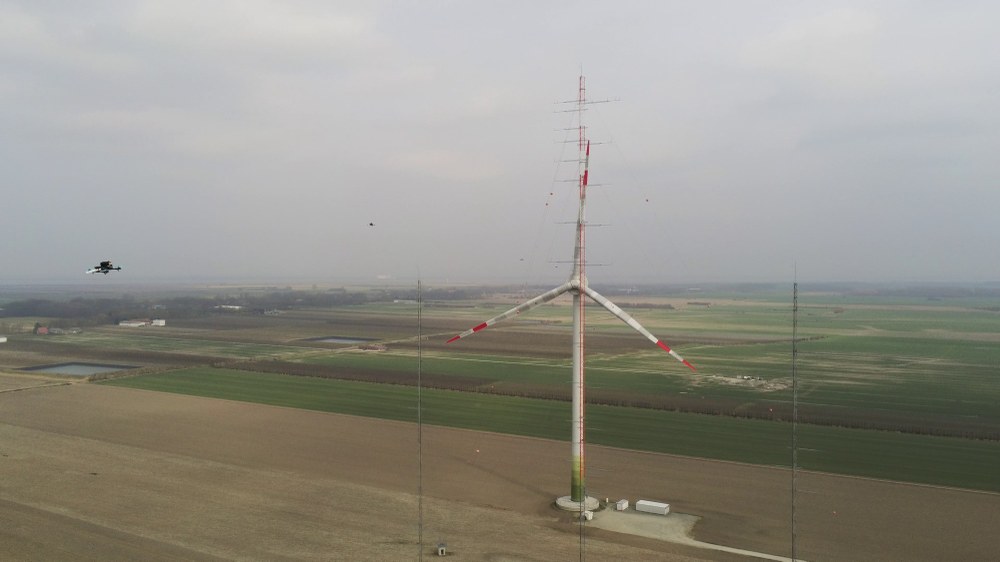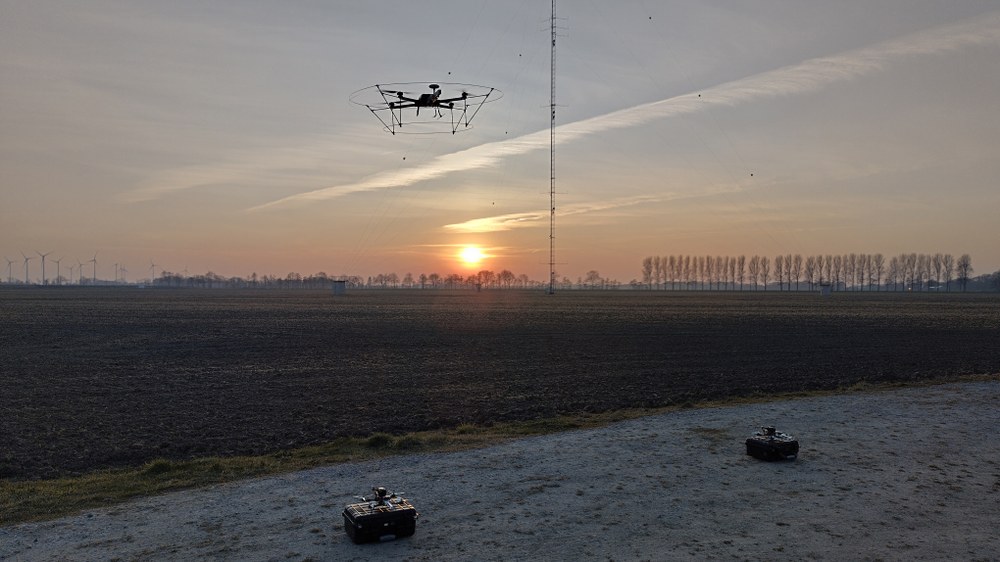DLR investigates the near wake of wind turbines



- In the NearWake project, DLR is investigating the propagation of the near wake behind wind turbines.
- For this first time, measurements using a swarm of drones were carried out at the WiValdi wind energy research farm in Krummendeich, Germany.
- The near wake of a turbine affects the performance and loads experienced by other turbines in a wind farm.
- Focus: Energy, wind energy research
A new measurement method debuts in the skies: In the NearWake project, a swarm of ten drones from the German Aerospace Center (Deutsches Zentrum für Luft- und Raumfahrt; DLR) has carried out measurements where stationary instruments cannot reach – directly in front of and behind the OPUS 1 and OPUS 2 wind turbines at the DLR WiValdi (Wind Validation) wind energy research farm in Krummendeich.
The NearWake project focuses on the propagation of the near wake – the airflow directly behind a wind turbine. This flow is slower and more turbulent, as the turbine extracts energy from the atmosphere by slowing the wind and converting its kinetic energy into electrical energy – that is, electricity. Researchers focussed on a maximum distance of two rotor diameters behind the turbine – in this case, 230 metres. Using the rotor diameter as a unit allows for comparisons between turbines of different sizes.
Turbulent and complex – the near wake
"The wake is an important and fascinating subject of research. Wind turbines are not usually stand-alone structures, but grouped together in wind farms. This means that the wake from one turbine impacts those behind it, which can significantly influence their performance and the loads acting on rotor blades and turbine systems," explains Norman Wildmann who oversees the NearWake project at the DLR Institute of Atmospheric Physics in Oberpfaffenhofen. "This is why the scientific investigation of wake effects is one of the core tasks of DLR's research wind farm. At the same time, the topic is highly relevant for both the onshore and offshore wind industry," Wildmann continues. As part of 'repowering' – replacing older turbines with newer ones – turbines are becoming larger and spaced more closely together, with the aim of making wind energy even more efficient, cost-effective and space-saving. "But with larger turbines positioned closer together, the wake effects also change. They become significantly more turbulent and therefore more complex. The physics of the near wake also influences the far wake, which in turn affects the loads acting on turbines and how they are operated".
Despite turbulence, the drones hold formation and collect data
In order to track wake effects more accurately, a small DLR team spent three weeks on site in Krummendeich for the NearWake campaign, carrying out approximately 100 flights with a swarm of drones. The small drones weigh less than one kilogram and are optimised for wind measurements. "They are exposed to turbulence and must constantly counter steer to maintain their position. In effect, they are like tiny weathervanes," explains Wildmann. An algorithm developed at DLR then collects and evaluates the collected measurement data.
Wildmann's team developed a 'choreography' for this study, practised it and carried it out in several flight campaigns between the research site's two wind turbines, at altitudes of up to 250 metres. The drones were positioned in two lines of five. The first line was positioned half a rotor diameter (57.5 metres) behind the first turbine, while the second line was a full rotor diameter (115 metres) behind it. The drones then had to maintain their position as precisely as possible for 15 minutes.
Comprehensive data for modelling and simulation
"The flight manoeuvres worked reliably even in the near wake, enabling us to collect comprehensive, high-quality data that corresponds well with those recorded by stationary measuring equipment," summarises Wildmann. One initial finding is that the particularly turbulent air vortices at the blade tips continue to travel farther with the wind in the wake than previously assumed and are an important factor. How quickly they dissipate depends primarily on atmospheric and weather conditions. The more precisely near wake processes and interactions are understood, the better turbine behaviours and their influence on each other can be simulated on a computer. "This will enable us to predict future performance and loads much more accurately, which will help industry to improve turbines and better plan wind farms to optimise their operation." According to Wildmann, there is already considerable interest from wind turbine manufacturers and operators.
The physical phenomena of wind turbine wakes are similar to those of aircraft wake vortices. However, in aviation, the speeds and environments are very different and the turbulence is significantly stronger. The DLR Institute of Atmospheric Physics can draw on decades of aviation research for its work on the NearWake project, particularly in the areas of measurement technology and simulation.
Since summer 2023, DLR has had a unique large-scale research facility on hand with the WiValdi Wind Energy Research Park in Krummendeich. Its aim is to gain a better understanding of wind energy and the factors the influence it. From its foundations to its lofty heights, the research park is equipped with more than 2000 sensors. These are located in the two wind turbines, on measuring masts and in the field, providing a continuous stream of valuable data.
Further information on the NearWake project
The project is led by wind turbine manufacturer ENERCON and Wobben Research & Development (WRD). DLR is working closely with both companies at the WiValdi research wind farm. Other participants in the NearWake project include the Technical University of Munich (TUM), the Center for Solar Energy and Hydrogen Research Baden-Württemberg (ZSW) and Carl von Ossietzky University Oldenburg (ForWind). The project is set to run until 2026.
